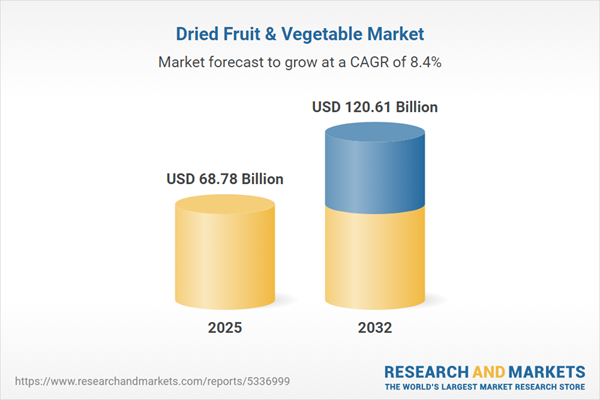Speak directly to the analyst to clarify any post sales queries you may have.
The dried fruit and vegetable market is undergoing rapid transformation as organizations align with shifting consumer expectations, evolving regulations, and digital technology integration. Senior leaders require focused market research to capture opportunities and steer strategy amid these changes.
Market Snapshot: Dried Fruit and Vegetable Market
The dried fruit and vegetable market is projected to grow from USD 63.41 billion in 2024 to USD 68.78 billion in 2025, with further expansion anticipated, reaching USD 120.61 billion by 2032 at a CAGR of 8.36%.
This growth is supported by increasing demand for nutrient-centric, minimally processed ingredients, as well as by ongoing advances in preservation methods and digital supply chain management. Companies prioritize digital tools and sustainability initiatives to meet consumer and regulatory expectations. Competitive dynamics are shaped by innovative newcomers and established players defining differentiation strategies, impacting application segments across established and emerging markets.Dried Fruit and Vegetable Market: Scope & Segmentation
- Product Types: The market features apricots, banana chips, blueberries, cranberries, strawberries, dates, raisins, blends, peas, potatoes, and tomatoes, designed to address diverse requirements in manufacturing and foodservice sectors through adaptable product features.
- Distribution Channels: Leading strategies include direct-to-consumer sales, e-commerce channels, and physical retail integration to broaden reach, enhance engagement, and optimize logistics across multiple geographic and commercial contexts.
- Packaging Formats: Offerings span from bulk industrial containers to resealable consumer pouches and robust protective canisters, aligning with varied quality assurance demands and catering to both business and consumer sales models.
- End Users: Key stakeholders include bakery and confectionery producers, ready meal companies, snack brands, hospitality industry operators, and retail organizations, each leveraging supply chain efficiencies and network integration for improved outcomes.
- Product Forms: Available formats such as chips, diced or sliced components, powders, and custom blends enable tailored product development and contribute to streamlined manufacturing operations.
- Applications: Principal uses encompass inclusion in snacks, baked products, cereals, meal supplements, and nutritional enhancers, catering to demands for wellness, convenience, and taste diversity among target demographics.
- Geographic Coverage: Market presence extends across the Americas, Europe, Middle East and Africa, and Asia-Pacific, where distinct regional dynamics and regulatory trends require customized go-to-market approaches.
Dried Fruit and Vegetable Market: Key Takeaways for Senior Leaders
- Clean-label development and transparent sourcing strengthen stakeholder trust and support sustainable partnerships throughout the market ecosystem.
- Enhanced dehydration and preservation contribute to reliable product quality and enable organizations to achieve scalable production despite fluctuating external conditions.
- Adopting digital traceability and solidifying supplier networks bolsters supply chain resilience and protects business continuity during operational disruptions or regulatory adjustments.
- Sustainable procurement, advanced packaging choices, and efficient sourcing methods promote regulatory compliance and support long-term vendor relationships while improving environmental performance.
- Agile logistics capabilities and adaptable packaging structures help companies meet regional regulations, optimize market entry, and address shifting consumer requirements with improved speed and flexibility.
- Collaboration in refining packaging and enhancing supplier partnerships aids in meeting environmental standards and achieving waste minimization targets across the value chain.
Tariff Impact on the Dried Fruit & Vegetable Market
Forthcoming tariff regulations in the United States for 2025 prompt procurement and sourcing leaders to update operational frameworks. Increased investment in process automation drives more efficient compliance and facilitates customs procedures. Shifting priorities toward domestic sourcing and revised supplier agreements have emerged as pivotal elements. Strategic risk management is critical for maintaining supply chain stability throughout periods of regulatory transition.
Methodology & Data Sources
This report is developed from comprehensive interviews with industry leaders, sector-specific surveys, and validated secondary research. Data has been cross-verified with trade associations and regulatory authorities to ensure accuracy and actionable insights for executive decision-making.
Why This Report Matters
- Empowers executive teams to proactively adapt strategies as regulatory environments and supply chain technologies progress, reinforcing competitive positioning and responsiveness.
- Supports the implementation of sustainable, compliance-aligned best practices to build organizational resilience amid changing industry conditions.
- Enables organizations to optimize procurement and logistics functions in line with ongoing transformation and innovation within the dried fruit and vegetable sector.
Conclusion
For organizations operating in the dried fruit and vegetable market, leadership focus on innovation, resilient supply chains, and sustainability delivers strategic advantage and supports long-term industry success.
Additional Product Information:
- Purchase of this report includes 1 year online access with quarterly updates.
- This report can be updated on request. Please contact our Customer Experience team using the Ask a Question widget on our website.
Table of Contents
3. Executive Summary
4. Market Overview
7. Cumulative Impact of Artificial Intelligence 2025
Companies Mentioned
The companies profiled in this Dried Fruit & Vegetable market report include:- Olam International Ltd.
- Dole Food Company, Inc.
- Conagra Brands, Inc.
- AGRANA Beteiligungs-AG
- Kerry Group plc
- Sun-Maid Growers of California
- Ocean Spray Cranberries, Inc.
- Calbee, Inc.
- McCormick & Company, Incorporated
- General Mills, Inc.
Table Information
| Report Attribute | Details |
|---|---|
| No. of Pages | 191 |
| Published | October 2025 |
| Forecast Period | 2025 - 2032 |
| Estimated Market Value ( USD | $ 68.78 Billion |
| Forecasted Market Value ( USD | $ 120.61 Billion |
| Compound Annual Growth Rate | 8.3% |
| Regions Covered | Global |
| No. of Companies Mentioned | 11 |









